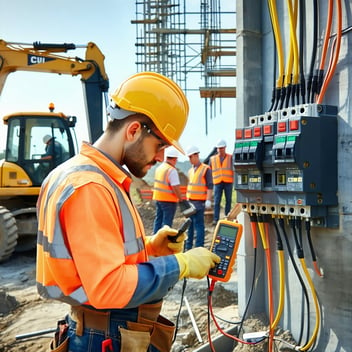Ensuring electrical safety on construction sites is crucial to protecting workers and maintaining project integrity. Discover essential tips to keep your team safe.
Understand the Importance of Electrical Safety Training
Electrical safety training is foundational for all workers in the construction industry. It equips employees with the knowledge and skills needed to recognize potential hazards, understand safe practices, and respond effectively to emergencies. Comprehensive training often includes information on electrical circuits, proper tool usage, and emergency response protocols. For a detailed guide on essential electrical safety training for workers, check out our resource.
Investing in thorough electrical safety training not only protects workers but also minimizes the risk of costly accidents and project delays. Regular training updates ensure that employees stay informed about the latest safety standards and technologies.
Use Personal Protective Equipment (PPE) Appropriately
Personal Protective Equipment (PPE) is crucial in protecting workers from electrical hazards. Essential PPE includes insulated gloves, safety goggles, face shields, and flame-resistant clothing. Each piece of equipment serves a specific function and should be used correctly to provide maximum protection. For more information on essential PPE requirements, visit our comprehensive guide.
Proper training on the use and maintenance of PPE is vital. Workers should regularly inspect their PPE for any wear and tear and replace it as necessary. Using PPE correctly can significantly reduce the risk of electrical injuries and ensure a safer working environment.
Regularly Inspect Electrical Tools and Equipment
Regular inspection of electrical tools and equipment is a key component of workplace safety. Before use, workers should check for damaged cords, exposed wires, and any signs of wear that could pose a risk. Tools should be maintained according to the manufacturer's guidelines to ensure they function correctly. Learn more about how to perform a proper electrical safety inspection in our detailed guide.
Implementing a routine inspection schedule helps identify potential problems before they lead to accidents. Keeping detailed records of inspections and maintenance can also assist in meeting regulatory compliance and ensure the longevity of the equipment.
Implement Lockout/Tagout Procedures
Lockout/Tagout (LOTO) procedures are critical for ensuring that electrical equipment is properly shut off and cannot be started up again before maintenance or repair work is completed. This prevents accidental energization, which could result in serious injury or death. For a comprehensive understanding of LOTO procedures and their importance, check out our detailed guide.
Workers should be thoroughly trained in LOTO procedures and understand their importance. Clear labeling and the use of standardized locks and tags can help ensure that all employees recognize and respect the locks and tags. Regular audits of LOTO procedures can further enhance safety on the construction site. For 50 practical Lockout Tagout safety tips, visit our comprehensive resource.
Stay Aware of Overhead and Underground Power Lines
Awareness of overhead and underground power lines is essential for electrical safety on construction sites. Workers should always assume that power lines are live and maintain a safe distance. Using non-conductive tools and equipment near power lines can also reduce the risk of electrocution.
Before digging or excavation work, it is crucial to locate and mark underground utilities. Following proper protocols and using detection equipment can prevent accidental contact with buried power lines, ensuring the safety of all workers on site.






Leave a Comment